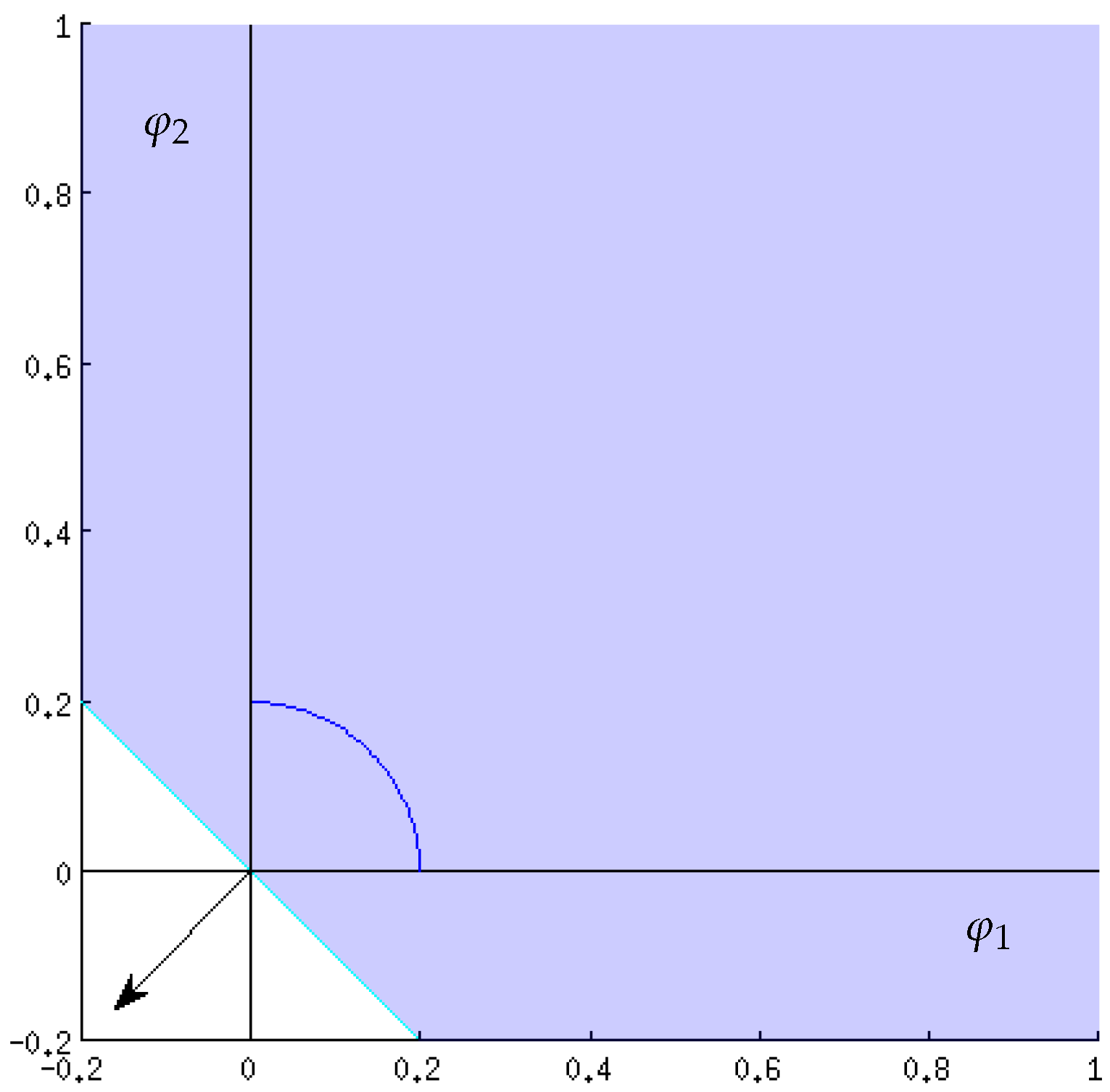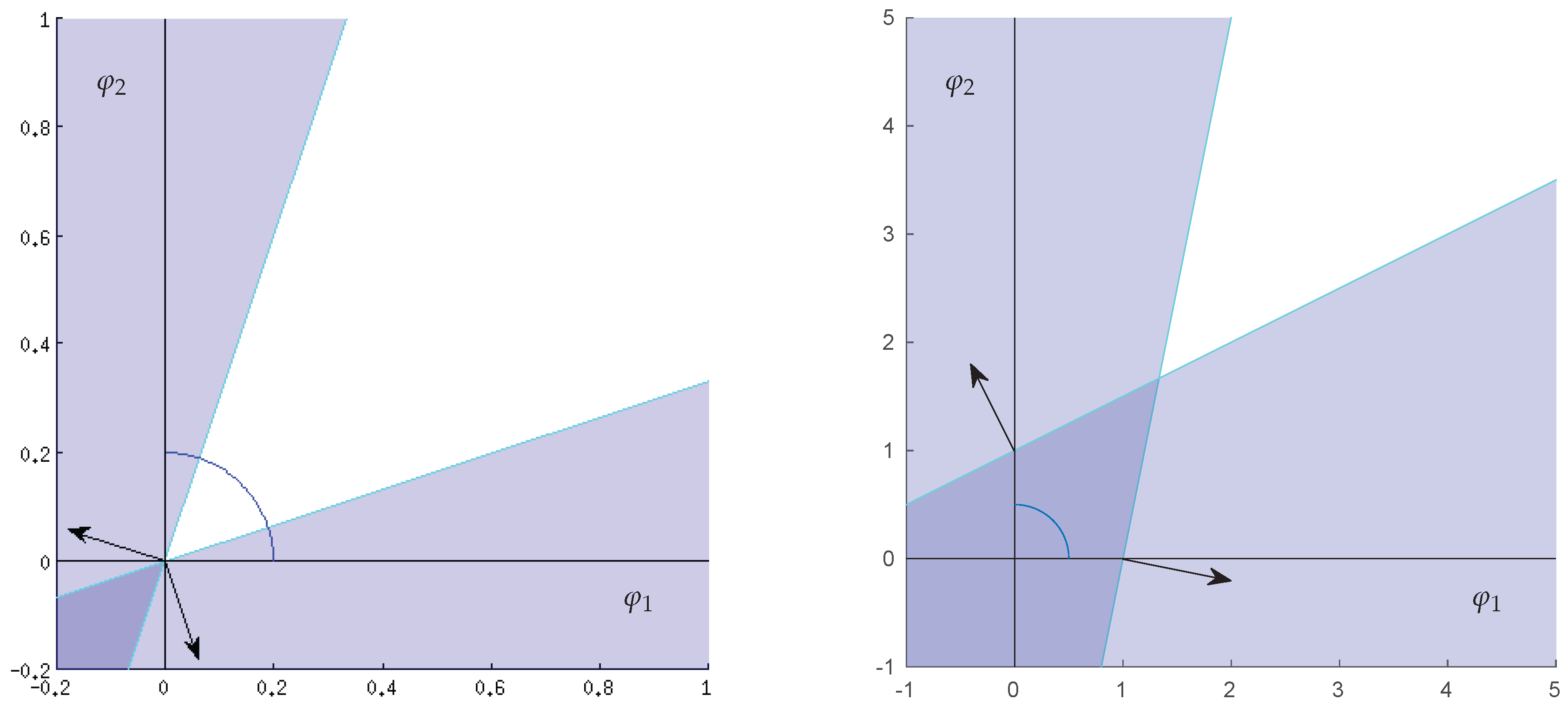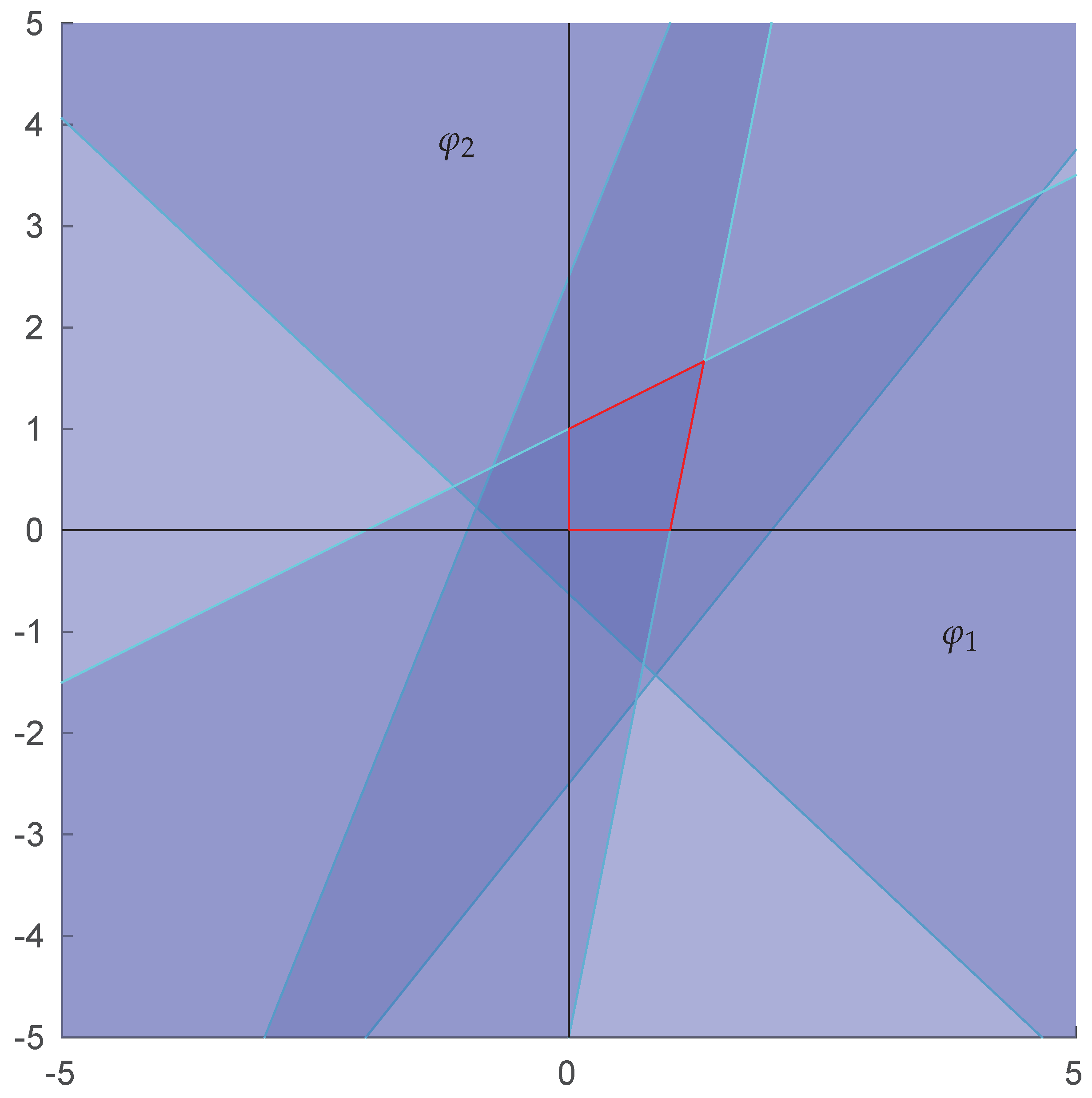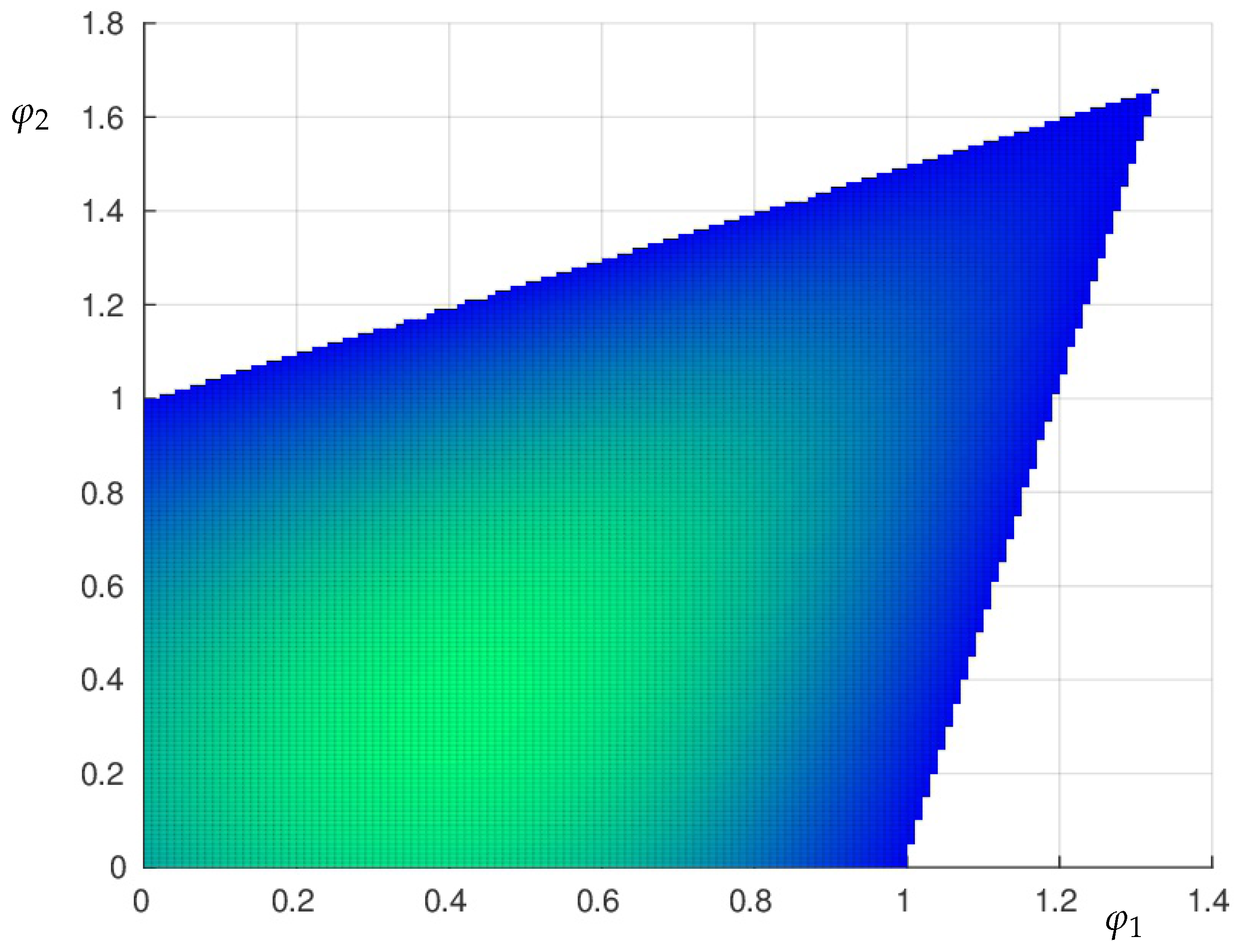1. Introduction
Risk and money management for investment issues has always been at the heart of finance. Going back to the 1950s,
Markowitz (
1991) invented the “modern portfolio theory”, where the additive expectation of a portfolio of different investments was maximized subject to a given risk expressed by volatility of the portfolio.
When the returns of the portfolio are no longer calculated additive, but multiplicative in order to respect the needs of compound interest, the resulting optimization problem is known as “fixed fractional trading”. In fixed fractional trading strategies an investor always wants to risk a fixed percentage of his current capital for future investments given some distribution of historic trades of his trading strategy.
A first example of factional trading was established in the 1950s by (
Kelly 1956) who found a criterion for an asymptotically optimal investment strategy for one investment instrument. Similarly, Vince in the 1990s (see (
Vince 1990,
1992)) used the fractional trading ansatz to optimize his position sizing. Although at first glance these two methods look quite different, they are in fact closely related as could be shown in (
Maier-Paape 2016). However, only recently (
Vince 2009) extended the fractional trading ansatz to portfolios of different investment instruments. The situation with
M investment instruments (systems) and
N coincident realizations of absolute returns of these
M systems results in a trade return matrix
T described in detail in (
2). Given this trade return matrix, the “Terminal Wealth Relative” (TWR) can be constructed (see (
4)) measuring the multiplicative gain of a portfolio resulting from a fixed vector
of fractional investments into the
M systems. In order to find an optimal investment among all fractions
the TWR has to be maximized
where
is the definition set of the TWR (see Definition 1 and (
8)).
Whereas (
Vince 2009) only stated this optimization problem and illustrated it with examples, in
Section 3 we give as our main result the necessary analysis. In particular, we investigate the definition set
of the TWR and fix reasonable assumptions (Assumption 1) under which (
1) has a unique solution. This unique solution may lie in
or on
as different examples in
Section 4 show. Our result extend the results of (
Maier-Paape 2013;
Zhu 2007) (
case only) and parts of the PhD of (
Hermes 2016) on the discrete multivariate TWR. One of the main ingredients to show the uniqueness of the maximum of (
1) is the concavity of the function
(see Lemma 5). Uniqueness and concavity furthermore guarantee that the solution of (
1) can always be found numerically by simply following steepest ascent.
Before we start our analysis, some more remarks on related papers are in order. In (
Maier-Paape 2015) showed that the fractional trading ansatz on one investment instrument leads to tremendous drawdowns, but that effect can be reduced largely when several stochastic independent trading systems are used coincidentally. Under which conditions this diversification effect works out in the here considered multivariate TWR situation is still an open question. Furthermore, several papers investigated risk measures in the context of fractional trading with one investment instrument (
; see (
De Prado et al. 2013;
Maier-Paape 2013,
2016;
Vince and Zhu 2013)). Related investigations for the multivariate TWR using the drawdown can be found in (
Vince 2009).
In the following sections, we analyse the multivariate case of a discrete Terminal Wealth Relative. That means we consider multiple investment strategies where every strategy generates multiple trading returns. As noted before this situation can be seen as a portfolio approach of a discrete Terminal Wealth Relative (cf. (
Vince 2009)). For example, one could consider an investment strategy applied to several assets, the strategy producing trading returns on each asset. However, in an even broader sense, one could also consider several distinct investment strategies applied to several distinct assets or even classes of assets.
2. Definition of a Terminal Wealth Relative
The subject of consideration in this paper is the multivariate case of the discrete Terminal Wealth Relative for several trading systems analogous to the definition of Ralph Vince in (
Vince 2009). For
we denote the
k-th trading system by (
system k). A trading system is an investment strategy applied to a financial instrument. Each system generates periodic trade returns, e.g., monthly, daily or the like. The absolute trade return of the
i-th period of the
k-th system is denoted by
,
. Thus, we have the joint return matrix
and define
Just as in the univariate case (cf. (
Maier-Paape 2013) or (
Vince 1990)), we assume that each system produced at least one loss within the
N periods. That means
Thus, we can define the biggest loss of each system as
For better readability, we define the rows of the given return matrix, i.e., the return of the
i-th period, as
and the vector of all biggest losses as
Having the biggest loses at hand, it is possible to “normalize” the
k-th column of
T by
such that each system has a maximal loss of
. Using the componentwise quotient, the normalized trade matrix return then has the rows
For
,
, we define the Holding Period Return (HPR) of the
i-th period as
where
denotes the standard scalar product on
. To shorten the notation, the marking of the vector space
at the scalar product is omitted, if the dimension of the vectors is clear. Similar to the univariate case, the gain (or loss) in each system is scaled by its biggest loss. Therefore the HPR represents the gain (loss) of one period, when investing a fraction of
of the capital in (
) for all
, thus risking a maximal loss of
in the
k-th trading system.
The Terminal Wealth Relative (TWR) as the gain (or loss) after the given
N periods, when the fraction
is invested in (
) over all periods, is then given as
Note that in the –dimensional case a risk of a full loss of our capital corresponds to a fraction of . Here in the multivariate case we have a loss of of our capital every time there exists an such that . That is for example if we risk a maximal loss of in the -th trading system (for some ) and simultaneously letting for all other . However these degenerate vectors of fractions are not the only examples that produce a Terminal Wealth Relative (TWR) of zero. Since we would like to risk at most of our capital (which is quite a meaningful limitation), we restrict to the domain given by the following definition:
Definition 1. A vector of fractions is called admissible if holds, where With this definition we now have a risk of
for each vector of fractions
and a risk of less than
for each vector of fractions
. Since
we can find an
such that
and thus in particular
holds.
denotes the Euclidean norm on
.
Observe that the
i-th period results in a loss if
, that means
. Hence the biggest loss over all periods for an investment with a given vector of fractions
is
Consequently, we have a biggest loss of
and
Note that for we do not have an a priori bound for the fractions . Thus it may happen that there are with for some (or even for all) , or at least , indicating a risk of more than for the individual trading systems, but the combined risk of all trading systems can still be less than . So the individual risks can potentially be eliminated to some extent through diversification. As a drawback of this favorable effect the optimization in the multivariate case may result in vectors of fractions that require a high capitalization of the individual trading systems. Thus, we assume leveraged financial instruments and ignore margin calls or other regulatory issues.
Before we continue with the TWR analysis, let us state a first auxiliary lemma for .
Lemma 1. The set in Definition 1 is convex, as is .
Proof. All the conditions
and
define half spaces (which are convex). Since
is the intersection of a finite set of half spaces, it is itself convex.
A similar reasoning yields that is convex, too. ☐
3. Optimal Fraction of the Discrete Terminal Wealth Relative
If we develop this line of thought a little further a necessary condition for the return matrix T for the optimization of the Terminal Wealth Relative gets clear:
Lemma 2. Assume there is a vector with then If in addition there is an such that then Proof. For arbitrary
the function
is monotonically increasing in
s for all
and by that we have
Moreover, if there is an
with
then
and by that
An investment where the holding period returns are greater than or equal to 1 for all periods denotes a “risk free” investment (
) and considering the possibility of an unbounded leverage, it is clear that the overall profit can be maximized by investing an infinite quantity. Assuming arbitrage free investment instruments, any risk free investment can only be of short duration, hence by increasing
the condition
will eventually burst, cf. (
7). Thus, when optimizing the Terminal Wealth Relative , we are interested in settings that fulfill the following assumption
always yielding
.
With that at hand, we can formulate the optimization problem for the multivariate discrete Terminal Wealth Relative
and analyze the existence and uniqueness of an optimal vector of fractions for the problem under the assumption
Assumption 1. We assume that each of the trading systems in (2) produced at least one loss (cf. (3)) and furthermore - (a)
- (b)
- (c)
Assumption 1(a) ensures that, no matter how we allocate our portfolio (i.e., no matter what direction
we choose), there is always at least one period that realizes a loss, i.e., there exists an
with
. Or in other words, not only are the investment systems all fraught with risk (cf. (
3)), but there is also no possible risk free allocation of the systems.
The matrix
T from (
2) can be viewed as a linear mapping
“
” denotes the kernel of the matrix T in Assumption 1(c). Thus, this assumption is the linear independence of the trading systems, i.e., the linear independence of the columns
of the matrix
T. Hence with Assumption 1(c) it is not possible that there exists an
and a
such that
which would make (
) obsolete. So Assumption 1(c) is no actual restriction of the optimization problem.
Now we point out a first property of the Terminal Wealth Relative.
Lemma 3. Let the return matrix (as in (2)) satisfy Assumption 1(a) then, for all , there exists an such that . In fact . Proof. For some arbitrary
we have
. Then Assumption 1(a) yields the existence of an
with
. With
and
we get that
and
for all
. Hence
and clearly
(cf. Definition 1). ☐
Furthermore, the following holds.
Lemma 4. Let the return matrix (as in (2)) satisfy Assumption 1(a) then the set is compact.
Proof. For all
Assumption 1(a) yields an
such that
. With that we define
This function is continuous on the compact support
. Thus, the maximum exists
Consequently the function
is well defined and continuous. Since for all
with equality for at least one index
, we have
and
hence
Altogether we see that
thus the set
is bounded and connected as image of the compact set
under the continuous function
g and by that the set
is compact. ☐
Now we take a closer look at the third assumption for the optimization problem.
Lemma 5. Let the return matrix (as in (2)) satisfy Assumption 1(c) then is concave on .
Moreover if there is a with ,
then is even strictly concave in .
Proof. For
the gradient of
is given by the column vector
where
. The Hessian-matrix is then given by
where
is a row vector. The matrix
can be rearranged as
Since the matrices
are positive semi-definite for all
, the same holds for
and therefore
is concave. Furthermore, if there is a
with
where
, the matrix
further reduces to
If
is not strictly positive definite there is a
such that
and we get that
yielding a non trivial element in
and thus contradicting Assumption 1(c). Hence matrix
is strictly positive definite and
is strictly concave in
. ☐
With this at hand we can state an existence and uniqueness result for the multivariate optimization problem.
Theorem 2. (optimal f existence) Given a return matrix as in (2) that fulfills Assumption 1, then there exists a solution of the optimization problem (8) Furthermore, one of the following statements holds:
- (a)
is unique, or
- (b)
.
For both cases , and hold true.
Proof. We show existence and partly uniqueness of a maximum of the
N-th root of
, yielding existence and partly uniqueness of a solution
of (
10) with the claimed properties.
With Lemmas 1 and 4, the support
of the Terminal Wealth Relative is convex and compact. Hence the continuous function
attains its maximum on
. For
we get from (
9)
which is a vector whose components are strictly positive due to Assumption 1(b). Therefore
is not a maximum of
and a global maximum reaches a value greater than
Since for all
holds, a maximum can not be attained in
either.
Now if there is a maximum on
, assertion (b) holds together with the claimed properties. Alternatively, a maximum
is attained in the interior
. In this case, Lemma 5 yields the strict concavity of
at
. Suppose there is another maximum
then the straight line connecting both maxima
is fully contained in the convex set
(cf. Lemma 1). Because of the concavity of
all points of
L have to be maxima, which is a contradiction to the strict concavity of
in
. Thus, the maximum is unique and assertion (a) holds together with the claimed properties. ☐
In the remainder of this section, we will further discuss case (b) in Theorem 2. We aim to show that the maximum is unique either, but we proof this using a completely different idea. In order to lay the grounds for this, first, we give a lemma:
Lemma 6. If from (2) is a return map satisfying Assumption 1 and if , then each return map , which results from T after eliminating one of its columns, is also a return map satisfying Assumption 1. Proof. Since each of the M trading systems of the return matrix has a biggest loss , , the same holds for the trading systems of the reduced matrix .
For , Assumption 1(b),(c) follow straight from the respective properties of the matrix T.
Now let, without loss of generality,
be the matrix that results from
T by eliminating the last column, i.e., the
M-th trading system is omitted. Let
,
, denote the rows of
and
the vector of biggest losses of
. Then for Assumption 1(a) we have to show that
such that
Using Assumption 1(a) for matrix
T and
the inequality
holds true. Thus, (
11) holds likewise. ☐
Having this at hand, we can now extend Theorem 2.
Corollary 1. (optimal f uniqueness) In the situation of Theorem 2 the uniqueness also holds for case (b), i.e., a maximum is also a unique maximum of in .
Proof. Assume that the optimal solution
is not unique, then there exists an additional optimal solution
with
. Since
is convex (c.f. Lemma 1), the line connecting both solutions
is fully contained in
. Because of the concavity of
on
(c.f. Lemma 5), all points on
L are optimal solutions. Therefore
L must be a subset of
, since we have seen that an optimal solution in the interior
would be unique. Hence, there is (at least) one
such that, for all investment vectors in
L, the trading system (
) is not invested. i.e., the
-th component of
, of
and of all vectors in
L is zero.
Without loss of generality, let
. Then
are two optimal solutions for
However, with that, the
-dimensional investment vectors
are two distinct optimal solutions for
With Lemma 6 the return map which results from T after eliminating the M-th column (i.e., (system M)) satisfies Assumption 1. Applying Theorem 2 to the sub-dimensional optimization problem, yields that and again lie at the boundary of the admissible set of investment vectors
Hence, we have two distinct optimal solutions on the boundary
for the optimization problem with (
M−1) investment systems. By induction this reasoning leads to the existence of two distinct optimal solutions for an optimization problem with just one single trading system. However, for that type of problem, we already know that the solution is unique (see for example (
Maier-Paape 2013)), which causes a contradiction to our assumption. Thus, also for case (b) we have the uniqueness of the solution
. ☐
Remark 1. Note that Assumption 1(c) is necessary for uniqueness. To give a counterexample imagine a return matrix with two equal columns, meaning the same trading system is used twice. Let be the optimal f for this one dimensional trading system. Then it is easy to see that , and the straight line connecting these two points yield TWR optimal solutions for the return matrix .
4. Examples
As an example we fix the joint return matrix
for
trading systems and the returns from
periods given through the following table.
Obviously every system produced at least one loss within the 6 periods, thus the vector
with
is well-defined. For
the
takes the form
where the set of admissible vectors is given by
Since for all
we have
When examining the 6-th row
of the matrix
we observe that Assumption 1(a) is fulfilled with
. To see that let, for some
,
, then
For Assumption 1(b) one can easily check that all four systems are “profitable”, since the mean values of all four columns in (
12) are strictly positive. Lastly, for Assumption 1(c) we check that the rows of matrix
are linearly independent
Thus, Theorem 2 yields the existence and uniqueness of an optimal investment fraction
with
,
and
, which can numerically be computed
In the above example, a crucial point is that there is one row in the return matrix where the -th entry is the biggest loss of (system k), . Such a row in the return matrix implies, that all trading systems realized their biggest loss simultaneously, which can be seen as a strong evidence against a sufficient diversification of the systems. Hence we analyze Assumption 1(a) a little closer to see what happens if this is not the case.
With the help of Assumption 1(a), for all
, there is a row of the return matrix
,
such that
. The sets
describe the hyperplanes generated by the normal direction
,
. Thus, each
from the set
has to be an element of one of the half spaces
In other words the set
has to be a subset of a union of half spaces
If there exists an index
such that
for all
, then the normal direction of the corresponding hyperplane is
hence
and therefore Assumption 1(a) is fulfilled.
Figure 1 shows a hyperplane for
and a row of the return matrix where all entries are the biggest losses, that means the normal direction of this hyperplane is the vector
However, it is not necessary for Assumption 1(a) that the set
is covered by just one hyperplane. Again for
an illustration of possible hyperplanes can be seen in
Figure 2. The figure on the left shows a case where Assumption 1(a) is violated and the figure on the right a case where it is satisfied.
Remark 2. Following our arguments concerning the example in (12) the question arises whether or not a trading system where biggest losses are realized simultaneously always implies insufficient diversification. In (12) this seems to be the case, but is this true in general? One way diversification is often measured in the literature is volatility or variance/standard deviation of the portfolio returns. In terms of modern portfolio theory where portfolios are searched for which either -
minimize risk for a given chance/utility level
- or
maximize chance/utility for a given risk level,
the volatility stands for the risk part. Transferring this setup for a trade–off between risk and utility to the TWR “utility function” would result in an optimization problem likewhere is a constant restricting the risk (or volatility) level and is a symmetric positive definite covariance matrix stemming from a trading game with trade returns as in (2). The optimization problem in (14) is quite similar to the Markowitz portfolio optimization. The only difference is that the Markowitz utility function “expected portfolio return” is exchanged by the concave function . Since of Theorem 2 solves (10) it is clear that will solve (14) for all . On the other hand, for solutions of (14) will also be “efficient” in this utility/risk setting. However, the volatility decreases as and therefore diversification certainly increases. As a matter of fact, among all efficient portfolios, has the highest volatility and thus the worst diversification. In that sense diversification of is not to be expected. For the next example we fix the return matrix
as
with
and
. Thus, the biggest losses of the two systems are
To determine the set of admissible investments (and to check Assumption 1) we examine the vectors
for
and solve the linear equations
The solutions for
are shown in
Figure 3.
Each solution corresponds to a “cyan” line. The area where the inequality
holds for some
is shaded in “light blue”. The set where the inequalities hold for all
is the section where all shaded areas overlap, thus the “dark blue” section. Therefore the set of admissible investments is given by
with
Assumption 1 is fulfilled, since
- (a)
the half spaces for rows 4 and 5 of the return matrix cover the whole set
(cf.
Figure 2b),
- (b)
and and
- (c)
obviously, the columns of the return matrix are linearly independent.
A plot of the Terminal Wealth Relative for the return matrix
from (
15) can be seen in
Figure 4 and
Figure 5 with a maximum at
Therefore the maximum is clearly attained in the interior .
The following example will show that the unique maximum
of Theorem 2 can indeed be attained on
, i.e., the case discussed in Corollary 1. For that we add a third investment system to our last example (
16) with the new returns
such that the vectors
,
, form the matrix
This set of trading systems fulfills Assumption 1(b) since .
Assumption 1(c) is satisfied as well, because the three columns of
are linearly independent. For Assumption 1(a) we have to show that
holds. If not, we would have an investment vector
such that (
20) is not true for all rows of the matrix
. In particular if we look at lines 4 and 5
the sum of both inequalities still has to be true
which is a contradiction to
being an element of
Now we examine the following vector of investments
with
the unique maximum of the optimization problem of the reduced set of trading systems from the last example (cf. (
18)).
The first derivative of the Terminal Wealth Relative in the direction of the third component at
is given by
Moreover with
being the optimal solution of the last example in two variables we have
and
Thus
is indeed a local maximal point on the boundary of
for TWR
5 with the three trading systems in (
19). Corollary 1 yields the uniqueness of this maximal solution for










